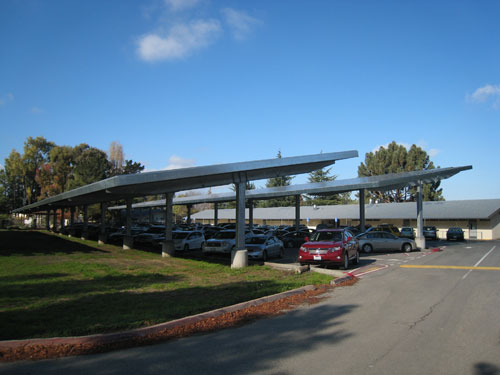
What do Millikin Basics+ Elementary School, Buchser Middle School, the Wilson Education Options campus and Peterson Middle School have in common? Solar shade structures have recently been installed at these school sites. This month, workers will start building these structures at the Santa Clara Unified School District office, and both Santa Clara High School and Wilcox High School will have them by the end of next summer.
“The shade structures are steel canopies,” says Larry Adams, director of school bond projects for the Santa Clara Unified School District. “In most cases, they’re covering parking lots. They look like a car port, and the solar panels are on top. They convert into direct current electricity. That electricity is fed into the electric company’s grid.”
According to Adams, the program to implement solar shade structures on various sites will save the school district more than $20 million over 25 years.
“A portion of the power that we buy from the utilities supplier is generated by burning fossil fuels,” Adams explains. “The more power we generate by ourselves using solar power, the less power we’ll need that comes from burning fossil fuels. The fossil fuels come from coal, oil, or natural gas. The electric bill is based on the difference between the electricity we generate and the electricity we consume. So the more solar energy we can generate, the less money [in utilities fees] we’d have to pay.”
Adams and his team at the school district have been working on projects to increase energy efficiency for the last two years. First, the group conducted research to see which sites could benefit the most from having reduced electrical bills. Then, members of the district developed specifications for the product requirements and various companies responded. Borrego Solar Systems, Inc. was the design-build vendor eventually awarded the contract.
“We had to get the building permits from the division of estate architects,” Adams says. “But the biggest challenge was incorporating the shade structures into the campuses so that we didn’t interfere with traffic or playgrounds or student activities. It takes about four months to build each shade structure.”
The voter approval of Measure H back in November 2010 has provided funding for a new school site in North San Jose, the reopening of closed school sites for enrollment growth, the implementation of health and safety provisions, and finally, the move to increase energy efficiency in the district. The district’s total budget for the funds allocated from the bond for all energy efficiency projects is $15 million dollars. Adams adds that the current solar energy project is estimated to cost about $12.5 million and the remainder of the bond funds for the energy efficiency projects will go towards other site improvements.
“I want to thank the voters for approving the bond to do this,” Adams says. “It has been gratifying to finally be able to do a project like this in our district. We have really worked hard on getting the best return on investment for that $15 million dollars. Every dollar we save can go back to the schools towards student instruction. And it’s also a great thing for the environment.”





